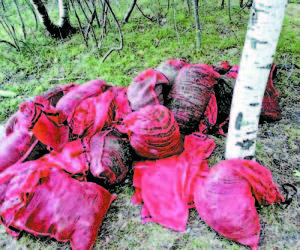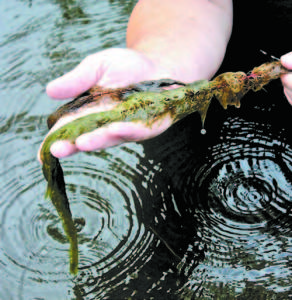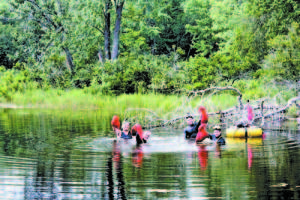Songo River: A clean-up success story
By Leigh Macmillen Hayes
Special to The News
The year was 2004 and the Songo River was so infested with the aquatic invasive variable-leaf milfoil (Myriophyllum heterophyllum) that people thought it was crazy for Lakes Environmental Association to take on the task of eradicating it.
If you know LEA’s Executive Director Peter Lowell, however, you know he welcomes a challenge.
Milfoil covered 60% of the river. In some coves and straight-aways, there were enormous infestations. Lowell describes it as looking like “guts in the water.â€
Variable-leaf milfoil has a thick, reddish stem with whorls of finely-divided leaves. The roots are thin and fragile — think angel hair pasta.
This milfoil prefers to grow in relatively calm and shallow (less than 20 feet) waters. Typically, it grows straight up, but in shallower water the stem turns and the plant begins to grow horizontally, thus creating a thick mat.
Its main form of reproduction is by fragmentation. Broken shoots are carried downstream by water currents, boats and waterfowl. It only takes a small piece of the plant to begin a new population.
Milfoil can negatively impact native species, recreation and even property values around infected waterbodies.
Traveling along the river last week with Adam Perron, LEA’s education director and invasive plants program coordinator, I learned that this summer there’s hardly a plant visible.
Our tour included visiting sites where the infestation had been heaviest, such as behind the sandbar at Sebago Lake State Park, by the rope swing along the river’s edge and at the Songo Lock basin.
Perron’s crew of interns consists of six to eight strapping young men. This is a skill-based job — learning to identify the plant, lay the barriers, scuba dive, etc. The learning curve is huge, so he appreciates that the team members return year after year.
Crew leader Christian Oren has been with the team for nine years, his brother, Tyler, for eight. Derrek Douglass and Thomas Chagrasulis are four-year members. Sullivan Tidd and Lucien Sulloway joined the crew two years ago.
Their work base is the SS Libra, a pontoon boat purchased with grant money from the Libra Foundation. The boat houses a Diver Assisted Suction Harvester.
The DASH provides an efficient method to remove milfoil from the water. It has a suction hose that divers carry into large infestations. While underwater, they harvest milfoil by the roots and feed the material into the hose.

The LEA milfoil crew used to collect 30 to 50 bags of variable-leaf milfoil a day. Now, they don't even fill one bag in a day.
Aboard the Libra, roots, stems and leaves are then processed in its sluiceway, which bags the plant material. This harvesting technique allows divers to remove large quantities while maintaining underwater visibility.
For smaller infestations, they remove plants by hand, placing the plant material in dive bags. Once harvested, the milfoil gets composted away from the water.
In some infested areas, the crew also uses benthic barriers to manage the invasive plant. To do this, they need permits from Maine’s Department of Environmental Protection.
Over the years, they tried a variety of materials including large tarps, shrinkwrap and biodegradable burlap, which they laid on the sediment and secured with stakes.
The benthic mats restrict sunlight from reaching the bottom; the absence of light on the substrate halts the growth of the plants — both native and invasive. This is a chemical-free form of treating the plants and is reusable.
The rotting vegetation produces gases and causes the mats to bubble up. Periodically, the crew deflates the bubbles to keep the barriers from becoming a problem for swimmers and boat props.
The barriers are removed after they’ve done their job of smothering milfoil, thus allowing native plants to regrow from the seedbank in the sediment.
On our journey, we stopped to chat with the crew. Douglass of Bridgton, recalls his first day on the job, “It was like a sea of milfoil. There were giant patches. It was really thick and you couldn’t swim.â€
One of the worst sections was at the shallow point by the rope swing. Boaters using the swing ignored the milfoil warning signs, thus driving right into the patch and breaking the plants into fragments.
At the state boat launch by Sebago Lake State Park, there was another solid band of milfoil four years ago. Now, there is little to no evidence of it.
In 2014, they worked on the channel that leads from the boat launch to Sebago Lake. This summer, they discovered some sparse re-growth, all easily removed by hand. While the crew continues to patrol, they’ve found no new patches.
Travel along the Songo River and into Brandy Pond and you’ll likely see the Libra anchored in a cove while the full crew is in the water searching for plants to handpick.
Throughout the 2015 season, Perron says they’ve surveyed areas where they had previously removed plants. The program has been highly successful and they often find either no invasive plants or only a few growing where they were once incredibly dense.
“We see a lot more native plants where there was milfoil. It’s now the correct habitat for them and huge schools of fish swim through,†Oren said.
It used to be that they harvested 30 to 50 bags worth of milfoil each day. And every two days, they made a trip to the compost pile. Now, their combined finds don’t fill one bag a day and they wait two weeks before dumping the weeds on the pile.
Lowell is extremely impressed with the work that has been completed and recognizes that all the money invested into this program has paid off. He never thought it would be as clean as it is today.
“We know now that we can control it,†he said.
John McPhedran, Maine DEP’s Invasive unit leader, is equally impressed. He encouraged Lowell and Perron to remove the milfoil signs along the river.
“Given LEA’s phenomenal success of controlling the milfoil in this river corridor — there are no longer dense patches of variable milfoil along the river — Peter and Adam agree with removal of the milfoil-related signs,†McPhedran said.
He also suggested that the yellow milfoil buoys be removed.
As we headed back to the dock, Perron said, “For 2016, the river won’t need us much. We’ll be here, but in an increasingly diminished capacity.â€
He feels strongly that the goal of preventing the milfoil from spreading further has been reached.
When a passing boater asks what we’re doing, Perron explains, “We’ve been managing this infestation for 10 years and we’re about wrapped up.â€
LEA is now investigating ways to assist with the extensive infestations on Sebago Lake. The crew is too good, too dedicated and too effective to disband.
Kudos to LEA and the crew for the success story on the Songo River and Brandy Pond. But, we all need to remember that fragments can stow away in boats, trailers and fishing tackle where they could potentially spread to unaffected bodies of water. Yes, it can be controlled, but the cost is high. It’s quite easy, however, to check your boat before and after you float to make sure you aren’t helping spread this and other aquatic invasive plants from one waterbody to another.



